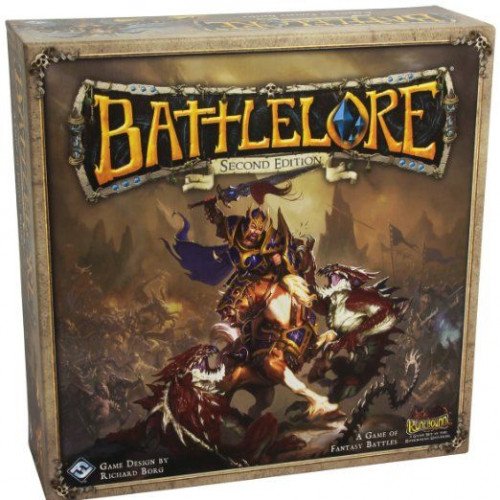BATTLELORE VS RITHMOMACHY

BATTLELORE
BattleLore is a strategy board wargame for two players, created by Richard Borg and initially published by Days of Wonder in 2006 (and later by Fantasy Flight Games). The game is based on the same mechanics as Battle Cry, Memoir '44 and Commands & Colors: Ancients, but has a fantasy and medieval theme. BattleLore debuted at the 2006 Spiel game fair in Essen, Germany and was released worldwide on November 30 of that year. Typical setup for a game is 10–15 minutes. Beginning players can expect a 45-60 minute duration game, but experienced players can usually finish a game in about 30–45 minutes. Each player has a set of quick reference cards to help him keep rules in mind. Experienced players will rarely have to pull out the rulebook for clarification. The scenario book that comes with the basic box is organised as a tutorial sequence that introduces concepts one adventure at a time, making the game very easy to learn. Each adventure in Battlelore is pre-constructed, leaving the work of creating armies to the scenario author. Although with the Call to Arms Expansion (released May 2007) the players have (limited) control on deploying units to any given scenario. The Battlelore website offers an online scenario builder that helps fans create their own adventures. In September 2008 Fantasy Flight Games and Days of Wonder announced that the game would be moving to Fantasy Flight Games, along with all remaining stock. In 2013, a revised version, BattleLore Second Edition, was released by Fantasy Flight Games.
Statistics for this Xoptio

RITHMOMACHY
Rithmomachy (or Rithmomachia, also Arithmomachia, Rythmomachy, Rhythmomachy, or several other variants; sometimes known as The Philosophers' Game) is a highly complex, early European mathematical board game. The earliest known description of it dates from the eleventh century. A literal translation of the name is "The Battle of the Numbers". The game is much like chess, except most methods of capture depend on the numbers inscribed on each piece. It has been argued that between the twelfth and sixteenth centuries, "rithmomachia served as a practical exemplar for teaching the contemplative values of Boethian mathematical philosophy, which emphasized the natural harmony and perfection of number and proportion. The game, Moyer argues, was used both as a mnemonic drill for the study of Boethian number theory and, more importantly, as a vehicle for moral education, by reminding players of the mathematical harmony of creation." Very little, if anything, is known about the origin of the game. Medieval writers attributed it to Pythagoras, but no trace of it has been discovered in Greek literature, and the earliest mention of it is from the time of Hermannus Contractus (1013–1054). The name, which appears in a variety of forms, points to a Greek origin, the more so because Greek was little known at the time when the game first appeared in literature. Based upon the Greek theory of numbers, and having a Greek name, it is still speculated by some that the game originated in Greek civilization, perhaps in the later schools of Byzantium or Alexandria. The first written evidence of Rithmomachia dates to around 1030, when a monk named Asilo created a game that illustrated the number theory of Boëthius' De institutione arithmetica, for the students of monastery schools. The rules of the game were improved shortly thereafter by another monk, Hermannus Contractus from Reichenau, and in the school of Liège. In the following centuries, Rithmomachia spread quickly through schools and monasteries in the southern parts of Germany and France. It was used mainly as a teaching aid, but gradually intellectuals started to play it for pleasure. In the 13th century Rithmomachia came to England, where famous mathematician Thomas Bradwardine wrote a text about it. Even Roger Bacon recommended Rithmomachia to his students, while Sir Thomas More let the inhabitants of the fictitious Utopia play it for recreation. The game was well enough known as to justify printed treatises in Latin, French, Italian, and German, in the sixteenth century, and to have public advertisements of the sale of the board and pieces under the shadow of the old Sorbonne.